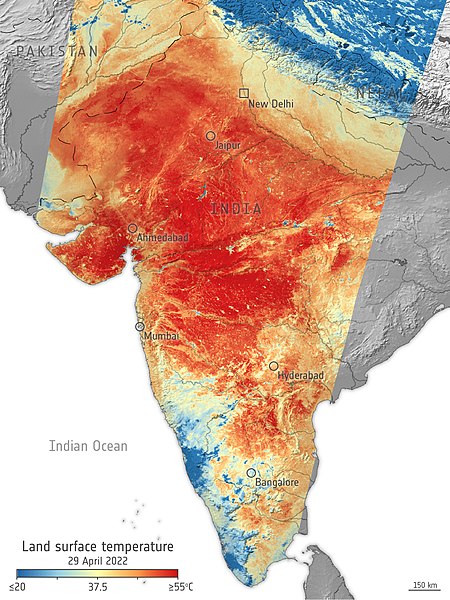
The government approved eight new highways with a budget of INR 50,655 crore. The announcement timing coincided with the Haryana, Maharashtra, Jharkhand, & J &K assembly polls. Will this announcement lure the voters, especially daily commuters in heatwaves?
In summer 2024, Mungashepur of Delhi recorded the highest-ever temperature of 52.9 0C. In other parts of the country, the mercury was trying to reach the mark. Ministry of Health confirmed 143 heatstroke deaths but other sources revealed 448. International media reported higher casualties.
As temperatures surpass 40 0C, the starting point of a heatwave, the topmost layer of roads, bitumen melts. Incidents of road surface melting were reported in Delhi, Zirakpur-Ambala National Highway, and Surat and Ahmedabad in Gujarat. In such a situation, 52% of Mumbai’s daily commuters use public transport, mainly local trains and buses whereas 43 Lakh Bangalorians and 28-31 Lakh Delhiites take buses.
Indian climatologists are reportedly raising alarms about future heatwaves in India and the desperate need for heat action plans. According to the Indian Meteorological Department, a heatwave is when the maximum temperature exceeds 40 degrees Celsius in plains and 30 degrees Celsius in hilly regions, says Dr. Vijendra Ingole, Office for National Statistics, United Kingdom.
The frequency and duration of severe heatwaves would increase 8 times by 2021-2050 and 30 times by 2100. The effect will be seen throughout the country, with more severity in the Indo-Gangetic plains, Malabar coast, and Mumbai, Delhi, and Kolkata metropolitan areas. Dr Vijendra Ingole, one of the researchers who studied heatwave impact on daily deaths in ten Indian cities adds, that it estimated around 1116 deaths annually due to heatwaves. Their research is published in the peer-reviewed journal- ‘Environment International.
Dr. Vijendra, the environmental epidemiologist, says heat waves have direct and indirect effects. Effects on transport are tire bursts, buckling of rails, melting wires, runways, and roads, which is apparent with increasing temperatures. Drivers or crew collapse due to heatstroke is an example of a direct effect. It can lead to staff unavailability and consequently, disruption in services. Daily commuting outdoor workers, pregnant women, and old people are the most vulnerable to heat waves.
The third time with the same portfolio of Road transport & highways, Mr. Nitin Gadkari himself was a victim of a heatwave in loksabha campaign for Eknath Shinde-led faction candidate Rajashree Patil in Maharashtra’s Yavatmal. He posted on X (formerly Twitter)- “I felt discomfort due to the heat at the rally in Pusad, Maharashtra.”
Political parties capture the frustrations of voters in their election campaign slogans. It was ‘Bijali, Sadak, Pani’ in 2002 which was later replaced by ‘Shiksha, Vigyan, Vikas’. With the credit of the country’s first unique projects like the Mumbai-Pune expressway and 55 flyovers in Mumbai, he needs to innovate while chasing the targets of the Bharatmala project. Can existing scientific education be used to improve our public transport system?
A lot of research and case studies worldwide are already available, we just need to implement them and integrate them into our urban planning and heat health action plans, Dr. Vijendra says. He suggests cost-effective solutions like providing drinking water at bus or rail stations, increasing urban green cover, setting speed limits for rails and vehicles, and shelters or cooling places.
Technology can always be a help. Applying solar radiation-reflecting white color coating on pavements, temperature and humidity sensors, and monitoring systems along transport networks can help. Combining temperature sensors with IoT can give better results.
The road transport ministry recently set to draft a policy for strengthening the aging national highways using white topping techniques- constructing a 100-200 mm thick concrete overlay on the existing bituminous roads. The draft by the ministry says concrete absorbs less heat and can help mitigate the urban heat island effect. Yet in the drafting stage, it will help only national highways which are just 2% of Indian roads. The country has the world’s second-largest road network of about 66.71 lakh km, of which 2% are national highways, 3% are state highways, and 95% are other roads.
Simple solutions by the state administration, such as bus shelters, drinking water & toilets can relieve daily commuters in a heatwave. In contrast, in January this year, 13,240 Delhites had to sign a petition to improve bus infrastructure, such as bus shelters. There are examples where commuters suffered due to faulty planning. Bihar government in 2016 spent Rs 18 lakh in setting up 10 bus queue shelters and spent another Rs 9.6 lakh in dismantling them. In sweltering heat, bus companies ignore to repair the air-conditioning of the A.C buses. Will the announcement of building a national highway help these commuters forget their inhumane commuting in the scorching heat waves?
It’s just six months to next summer and time will show, what will happen when ‘Ab ki Baar (mercury will be) 40 paar.’

Dr. Jaimini Sarkar has a Ph.D. in Science from the University of Mumbai. She worked as a visiting faculty member for an M.Sc. in biotechnology for a decade at the University of Mumbai. She is a recipient of the S. Ramaseshan Science Writing Fellowship at the Current Science Association, Indian Academy of Sciences at Bengaluru. She writes for Current Science, Science Reporter, The Wire, The Analysis, and Dkoding.in, BMJ, Down-To-Earth, Srote etc.

